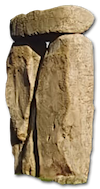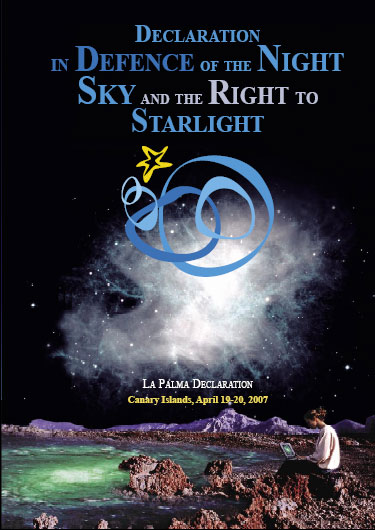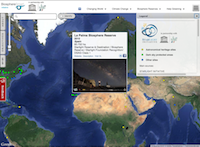Clear Skies and Biodiversity

That starlight should be a common heritage would seem beyond question to most people – yet those same people probably little realize that they are being “robbed” each night of the ability to see just that heritage!! We have , as we become more and more urbanized, lost the ability to see the stars which informed the lives of our ancestors, and we are polluting ourselves with more an more light. While the research on the effects of light pollution is still very new, the reports in this volume have some clear warnings – we should be careful!!
But the heritage of starlight is a fascinating topic, covering everything from Astronomy to rhythms of plants and animals, from the role of protected places for nature in conserving starlight as well to the enormous cultural heritage coming from the stars. Losing that heritage, like any other, diminishes us a humans just a little".
PETER BRIDGEWATER. Secretary General. Convention on Wetlands (Ramsar, Iran, 1971). (Starlight Conference 2007).
"We have only just begun to understand the decisive impact of the clarity of the sky on the conservation of biological diversity and ecosystems. As over half of the creatures living on this planet are nocturnal, any degradation in the quality of sky, by day or by night, will have a profound effect on their behaviour and on the equilibrium of the biosphere".
AHMED DJOGHLAF. Executive Secretary. Secretariat of the Convention on Biological Diversity (Starlight Conference 2007).
"The effects of light pollution on humans who can of course survive and can use tools to orientate themselves during the night are less devastating than the consequences for animals.The impacts on animals are diverse and complex. Light pollution can for instance confound animal navigation (many species use the horizon and stars for orientation), alter competitive interactions and reproduction behavior, change the natural predator-prey relationship and affect animal physiology".
ROBERT HEPWORTH. Executive SecretarySecretariat of the Convention on the Conservation of Migratory Species of Wild Animals. (Starlight Conference 2007).
LIGHTS OUT! FOR NATURE
Humans have radically transformed the physical characteristics of the nighttime hours in ways that would have been unimaginable only a hundred years ago. The cost of industrial development, affluence, and mass consumption has been the loss of natural patterns of darkness over vast expanses of the Earth’s surface, both on land and at sea. A substantial and growing body of research on the ecological effects of artificial night lighting is now available. New scientific articles that extend this knowledge are being published at a steady rate. Sufficient information is now available to devise policies to mitigate and avoid the range of profound, adverse consequences on other species caused by artificial light at night. Urban planners and open space managers can incorporate this knowledge to better protect nature at night.
TRAVIS LONGCORE AND CATHERINE RICHThe Urban Wildlands Group, USA (Starlight: A Common Heritage 2007).
There are at least nine reasons to reduce light pollution and to protect a natural night sky. They go beyond nature conservation to touch upon appropriate design and land development control policies.
- To preserve the ecological integrity of natural environments.
- To ensure the full enjoyment of a wilderness experience.
- To appreciate the integrity, character and beauty of rural landscapes.
- To protect and present the commemorative integrity (authenticity) of cultural sites.
- The preserve traditions that relate to celestial mythologies, navigation and other cultural aspects.
- The protect human health, both medical and psychological.
- To contribute to energy efficiency.
- To benefit scientific and amateur astronomy and the right to enjoy the night sky.
- To improve personal security through non-glare lighting in urban areas.
DSAG-2010
IUCN Dark Sky Advisory Group (DSAG)
The Final Report of the Starlight Reserves Working Group (Fuerteventura, 2009) include "the establishment of a dark sky advisory group within the IUCN WCPA to support IUCN activities in relation to dark skies, promoting dark sky values where applicable to protected areas, and complementing the work of ICOMOS on heritage issues of Starlight.
Established in 2009, the Group provides advice and guidance on behalf of the International Union for Conservation of Nature (IUCN) to other bodies in regards to light pollution and dark sky values, in particular as they relate to the ecological and commemorative integrity, visitor appreciation and public understanding of protected areas, and the long term maintenance of dark sky values for future generations. In connection with IUCN's role as an Advisory Body to the World Heritage Convention, the Group will also advise, assess and make recommendations to the IUCN Secretariat in regards to World Heritage studies and nominations that address or touch upon dark skies and light pollution.The group consists of members of the Cities and Protected Areas Specialist Group, which in turn reports to the World Commission on Protected Areas of IUCN. Depending on the nature of the group's work, outcomes and products may be subject to approval of the Specialist Group or the Commission.Group members volunteer their time, either within the scope of their employment or business or as private citizens. This means that the Group does not have the capacity to respond to requests for advice from individuals. Subject to its capacity and priorities as outline above, it will endeavour to respond to requests for advice directly from organizations.As part of its advisory role, the Dark Skies Advisory Group web pages will be developed to provided summaries of key aspects of light pollution abatement and dark skies protection, such as the ecological impacts and tourism benefits. These summaries will provide links to more comprehensive web sites endorsed by the DSAG.
Access to DSAG
LOOKING FOR SOMETHING?


Starlight Initiative collaborates with the
PORTAL TO THE HERITAGE OF ASTRONOMYUpdates
- New Brochure of UNESCO`s MAB Programme partnership
- Galicia adopts the Starlight Declaration
- Starlight at the 39th session of the World Heritage Committee
- International declaration warning about the effects of blue-rich white light
- Flyer - Starlight Initiative in partnership with the UNESCO MAB Programme
- Astronomical Heritage - Hawaii 2015
- 2015 International Year of Light
- Montsec - Starlight Destination and Reserve
Starlight Finder
Starlight related links
![]()
Covenant of Mayors Related Initiative
![]()
Colaborating with IAU Working Group
![]()
IUCN Dark Sky Advisory Group
![]()
Dark Skies Awareness Project
![]()
Partnership Unesco-MaB
![]()
Member of the Knowledge Network
![]()
Instituto de Astrofísica de Canarias
|
The Starlight Initiative is designed as an international action in defence of the values associated with the night sky and the general right to observe the stars. It is open to the participation of all scientific, cultural, environmental, and citizens' organizations... |
In partnership with: |
|
|
|



